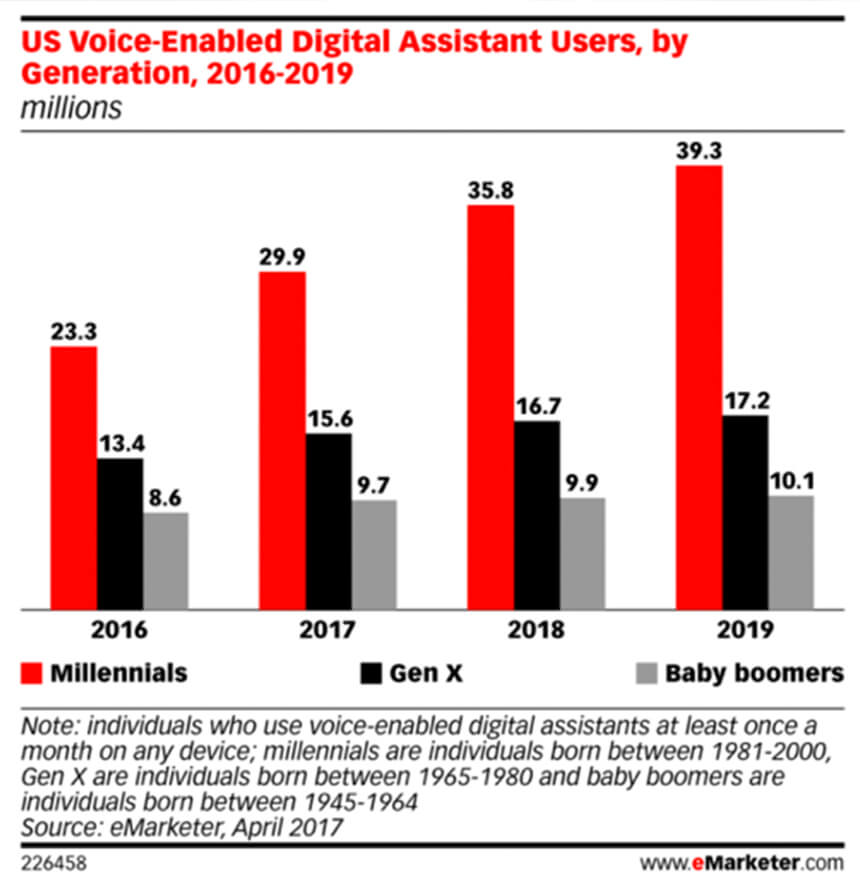
Navigate an unpredictable landscape with actionable, data-driven strategies tailored for your business from the brand down to the local level.

As we near the end of 2017, it’s customary to look back on what has been another significant year in digital, and take stock of how we’ve evolved as an industry. In particular, we thought it might be nice to share with you five of our favourites trends and innovations that we’ve seen emerge, which are not only helping to transform the digital marketing space, but also present exciting opportunities for the year ahead.
And so, in no particular order, we begin with…

Greg Jones, director of VR and AR at Google, said earlier this year: “At some point, we’re going to look back and think, how did we not have a digital layer on the physical world.” Early Augmented Reality (AR) prototypes were unconvincing and for quite some time seemed rather over-hyped; but in 2017 the technology has come on leaps and bounds, and it’s telling that the world’s largest companies, such as Google, Facebook and Apple, are investing heavily in it. In 2017 we’ve seen some trailblazing brands experimenting with AR and VR with success, from catwalk shows to shopping, and as a storytelling format, it is showing great potential.
“I don’t think there is any sector or industry that will be untouched by AR,” Apple CEO Tim Cook said in an interview with Vogue this year, and we see AR completely transforming the world of experiential marketing in particular, opening up a fully immersive 3D experience for consumers. Studies have shown that this technology can be an incredibly powerful emotional engagement tool, even more so than TV, which could significantly help to strengthen consumer relationships.
Moving forward, the digital marketing community has the opportunity to be exceptionally creative and lead the way in AR and VR, giving consumers unprecedented access to brand figures, unseen product, celebrity endorsers, etc. For example, this year Nicole Kidman starred in a five-minute short film for Etihad Airways, titled “Reimagine”, which took viewers on a 360-degree virtual reality story. The concept was to immerse viewers in an experiential journey following Kidman through one of Etihad’s new Airbus A380s flying non-stop between New York and Abu Dhabi. Shane O’Hare, SVP of marketing for Etihad, in an interview with Adweek, said: “Some things need to be experienced, not explained. You don’t explain the taste of a meal at a high-end restaurant or the feel of good linen in a five-star hotel bedroom. In the same way, our incredible A380 product cannot adequately be described by words alone, or by traditional film, or even by 3D film alone. It has to be experienced. Virtual reality allowed us to make that experience real for viewers.”
2017 was the year when chatbots truly came to life for brands, although with mixed success for some. With social media messaging on the rise, and artificial intelligence systems becoming increasingly sophisticated, it seems chatbot are the way customers would like to converse with brands, once brands have a good enough grasp of the creative execution.
In a survey by Oracle of senior marketers from France, the Netherlands, South Africa, and the UK, 80% of the respondents said they already used chatbots or planned to use them by 2020. Forty-two percent of participants are embracing automation technologies, 48% are already using automation technologies, and 40% are planning to implement automation by 2020. The ease of building a customisable bot is clearly appealing to brands, and Facebook’s expansion of Messenger, for example, is making it an increasingly accessible space.
This Christmas M&S has launched its Christmas Concierge chatbot, via Facebook Messenger, which asks users to opt-in to receive daily tips on food, hosting and presents, and they can also browse and shop from a series of curated festive while interacting further with the bot will surface “hidden messages” like a Percy pig cameo and jokes. There’s something for everyone, with clever video integration also.
And so, as we move into 2018, we see chatbot architecture evolving to the point that it will become the first port of call for customer service enquiries, among other things.
The impact of social media on influencer marketing has truly been felt this year, and the line between traditional celebrity and social talent has become more blurred than ever, and has certainly reached tipping point.
As the younger generation particularly place greater faith in social media influencers, and become more wary of celebrity endorsements (for example a recent US study by Roth Capital Partners found that 78% of millennials either had a negative view of celebrity endorsements, or were indifferent to the practice with regard to making a purchase), celebrities are increasingly needing to find new ways to differentiate themselves and forge more meaningful partnerships with brands. For example, Virgin Media recently announced it had appointed athlete Mo Farah as ‘director of going the extra mile’.
We particularly liked the Drum’s Celebrity Job Generator designed for marketers looking for inspiration in their hunt for a VIP with a unique job title.
Subscribe to our monthly newsletter.

In 2017, we’ve gone voice assistant mad, and although it still has a way to go, Apple, Amazon, and Google have made leaps and bounds on advancements in voice recognition with Siri, Alexa and Google Assistant, respectively. This year, 35.6 million Americans were predicted to use a voice-activated device at least once per month (not counting those on smartphones), eMarketer estimated – a 128.9% increase over 2016. In Singapore, nearly half of the population has tried voice technology services and a quarter of them use such services monthly.
According to a study by Stanford computer scientist James Landay, speech recognition is on average three times as fast as typing on a smartphone, and the error rate has dropped 3.6%, so it’s easy to see why the technology is proving so popular. We anticipate that by the end of 2018, usage will be far more sophisticated, and go far beyond basic requests such as setting an egg timer for cooking. Voice is far more intuitive and easier to use than text and is gradually delivering a much smarter experience, and some are calling this the era of ‘calm technology’ where people can easily use technology without being taxed to learn it.

This year the internet has become much more visually-focused, and the major search engines such as Google and Bing are investing in heavily in developing their own visual search engines. Image processing in our brain is 6,000 times faster than reading text, and visual search can be far more intuitive since it isn’t restricted to a limited range of keywords. Moving forward, reliance on text-based search is looking very likely to be replaced with image-based search.
In 2017, Pinterest launched its visual search solution, Pinterest Lens, and it recently raised $150 million in funding, a portion of which will help support the development of its visual search technology. Around the same time, Google announced its visual search tool, Google Lens, at its annual developer conference. And eBay and Pinterest have also launched new visual search technology meaning the camera becomes a greater focal point for mobile discovery.
So, as we move into 2018, brands need to focus on optimising their visual content for SEO purposes, if they aren’t already.
Navigate an unpredictable landscape with actionable, data-driven strategies tailored for your business from the brand down to the local level.
Navigate an unpredictable landscape with actionable, data-driven strategies tailored for your business from the brand down to the local level.
Navigate an unpredictable landscape with actionable, data-driven strategies tailored for your business from the brand down to the local level.
Subscribe to our monthly newsletter.